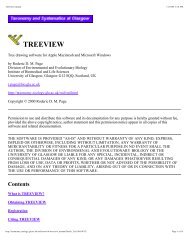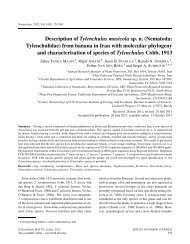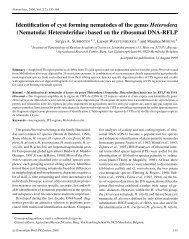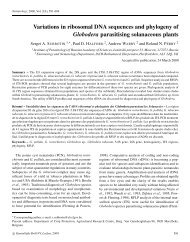Madina Rasulova Molecular Systematics of Nematodes Page 1
Madina Rasulova Molecular Systematics of Nematodes Page 1
Madina Rasulova Molecular Systematics of Nematodes Page 1
Create successful ePaper yourself
Turn your PDF publications into a flip-book with our unique Google optimized e-Paper software.
level analyses because <strong>of</strong> appreciable nucleotide polymorphism (Campbell et al., 1995; Chilton et al.,<br />
1995; Ferris et al., 1995). 18S and 28S genes <strong>of</strong> rDNA have a characteristic to evolve very slowly and can<br />
be used to compare distant taxa where divergence occurred long ago. In comparison, two ITS regions have<br />
higher evolution rates and consequently have been used for analysis <strong>of</strong> relatively recent evolutionary<br />
events. Consequently, ITS regions are very important in comparison <strong>of</strong> closely related species (Subbotin<br />
and Moens, 2006) and subspecies and play a role <strong>of</strong> a genetic marker in taxonomic studies (Cherry et al.,<br />
1997). Moreover, rDNA sequences which encode for rRNA (only SSU, 5.8S and LSU are present in<br />
mature rRNA after splicing) are present in abundant amount as it is common to find them from hundreds<br />
to thousands <strong>of</strong> tandemly arranged repeats which are separated from each other by intergenic spacer<br />
regions (IGS). Thus, several investigations based on molecular data were carried out in order to improve<br />
the understanding <strong>of</strong> Belonolaimus’ systematics, phylogeny and distribution (Cherry et al., 1997; Gozel et<br />
al., 2006; Han et al., 2006).<br />
For phylogenetic analysis 13 species <strong>of</strong> nematodes were chosen, 9 out <strong>of</strong> which were considered as<br />
in-group to the previously identified from the given sequence Belonolaimus species and they were<br />
selected according to the genus they belong to (all <strong>of</strong> them were members <strong>of</strong> the Belonolaimus genus).<br />
The rest 3 species were chosen from different families or at least different genera and were considered as<br />
out-group.<br />
For analyzing the relationship <strong>of</strong> the chosen species several programs were run which are listed<br />
below:<br />
BLAST (Basic Local Alignment Search Tool) is used for finding regions <strong>of</strong> local similarity<br />
between given sequence and other sequences available in databases. The principle <strong>of</strong> the program is<br />
based on comparison <strong>of</strong> nucleotide or protein sequences to sequence databases and calculates the<br />
statistical significance <strong>of</strong> matches. Two <strong>of</strong> the most important parameters in BLAST are expect value<br />
(represents the rate <strong>of</strong> found hit just by accident, meaning the smaller the E value – the less possibility<br />
<strong>Madina</strong> <strong>Rasulova</strong> <strong>Molecular</strong> <strong>Systematics</strong> <strong>of</strong> <strong>Nematodes</strong> <strong>Page</strong> 5
















